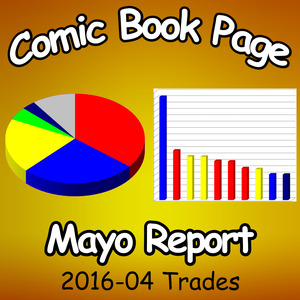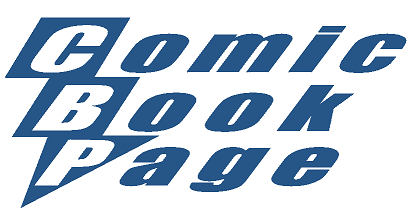Mayo Report for 2016-04

|

|
Top Comics List Top Comics Breakdown Top Trades List Top Trades Breakdown
In April 2016, Marvel accounted for 52.60% of the total unit sales in the top 300 comics. DC accounted for 27.24%, Image had 7.51% and IDW had 3.16%. Essentially, DC had roughly half the sales of Marvel, Image roughly a quarter the sales of DC and IDW about half the sales of Image. This sort of breakdown of the large publishers isn't unusual. Ideally, DC would be stronger competition for Marvel and maybe that will be the case with Rebirth like it was at the beginning of the New 52.
The bestselling comic book in April was "Black Panther" #1 with 253,258 units and a $4.99 cover price. This is far higher than I expected and completely unsustainable. In addition to the regular cover, another 10 variant and incentive covers of the issue were offered in the February Previews. The variant cover by Sanford Greene could be freely ordered. The inventive covers were offered in 1-in-20, 1-in-25 (two different covers), 1-in-50 and 1-in-75 ratios and three different covers could be ordered if the retailer's order for the regular cover of "Black Panther" #1 exceeded 125% of their orders for "Doctor Strange" #2. That doesn't even factor in the GameStop exclusive or the Marvel Collector Corps exclusive. "Black Panther" #2 which was just released on May 11th has another free to order Sanford Green variant, a 1-in-25 Ago of Apocalypse incentive cover by Frank Cho and an another incentive cover each retailer could order as much as they want of if their orders for the regular cover of "Black Panther" #2 exceed 80% of "Black Panther" #1.
In second place, and also at $4.99, was "Star Wars: Poe Dameron" #1 with 173,322 units. This issue had incentive covers at 1-in-15, 1-in-25, 1-in-50, 1-in-100 and 1-in-200 ratios. Four additional covers could be orders in any quantity if the order for the regular cover exceeded the retailer's order for "Star Wars" #12 (the final part of the Showdown on Smuggler's Moon story immediately before the Vader Down crossover storyline). One of those covers also required opting in to the launch party for the comic.
In fourth place was another $4.99 comic, "Star Wars: C-3po Special" #1 with 120,841 units. Two covers could be ordered in any quality by retailers which ordered more of the regular cover of this issue than they did of "Chewbacca" #2. Three incentive covers were offered, one at a 1-in-15 ratio and two at a 1-in-25 ratio.
Marvel is clearly using variant and incentive covers to increase sales. Variant covers which retailers can freely order aren't inherently damaging to the industry. Incentive covers which force retailers to order excessive numbers of the regular cover in order to be able to order copies of the incentive cover result in over ordering of comic which can be damaging to the industry. We've seen this sort of collector bubble burst back in the 1990s and is fundamentally changes the comic book market landscape. That having been said, collectors seem to be buying these incentive covers so it makes sense for Marvel to serve a portion of the overall comic book buying audience. If the bubble does burst, it will probably do so quickly and we'll go from seeing dozens and dozens of variant and incentive covers hand to a handful or less in very short order. Hopefully we won't see too many local comic book shops vanishing at the same time.
Just doing the math for these various incentive covers can get a bit involved requiring the retail look up how many copies of various past issue they ordered. The various exceed-orders-of incentive covers from Marvel in the May 2016 Previews required knowing the orders of 23 past covers spread over the previous five order forms.
For any retailers reading this, if these incentive covers are working for you, great. I urge caution in this area. Having readers preorder these (including putting down money) is something to consider, particularly for the 1-in-100 or 1-in-200 covers. There is a world of different between providing collectibles for customers and gambling on the collectability of these covers as a business model. I would be interesting in hearing different retailers do the math on these incentive covers to determine how many of each cover to order while remaining profitable overall on the issue.
Over at DC, "Dark Knight III: The Master Race" #4 was the best seller with 143,054 units of the regular issue. "Batman" #51 sold 101,922 units. The final issue of the volume was just released on May 11th and I'm curious if it sells over 100,000 units or not. So far, every issue of the series has remained over 100,00 units, including the weekly Villains Month issues if you aggregate the sales of the 2D and 3D covers.
The DC super-hero titles averaged around 27,195 units in April 2016 with a total of 1,386,947 units and median sales of 21,168 units. The titles DC is "doubling down" on and taking twice monthly with Rebirth average 36,977 units in April 2016 with a total of 517,675 units and median sales of 28,583. This isn't a matter of DC just keeping the top selling titles and jettisoning the rest. The Justice League and Titans seem to be forming the core of the re-aligned DC universe with the various other franchises being a bit more balanced unlike the heavy focus on the Batman franchise during parts of the New 52 era.
Hopefully Rebirth will re-energize the DC readership. As a currently disenchanted DC reader myself, I really hope that happens. But, I'm skeptical. For something like Rebirth to be needed less than five years into the New 52 implies there is something systemically wrong at DC. When the Co-Presidents of DC are publicly stating a need to rebuild the fan base because things got off track during the New 52 period. Dan Didio and Jim Lee actively treating comics as a business-to-business-to-consumer business model is a very important thing. They clearly realize selling into retailers only matter if consumers are buying the books. The retailer is the direct customer for DC (and the other publishers). DC hasn't suddenly realized retailers will only order what they can sell to readers. What is different is DC having a very explicit and publicly stated focus to make the products more appealing and easier to sell to readers. Hopefully, this focus on the content of the comics and what make each character unique and interesting will increase sales for DC.
With 80% of the units sold for top 300 comics being produced by Marvel and DC, the way these two publishers operate has a profound influence on the rest of the industry. What we are seeing is a difference in philosophy from Marvel and DC. Marvel is leveraging incentive covers and higher prices and, frankly, as the market leader they are in a position to do so. Meanwhile, DC as the underdog in this fight is having to focus more on the fundamentals of character and storytelling to regain their footing in this battle in the marketplace. Cover versus content is an oversimplification. Marvel isn't lacking in the content area and DC isn't lacking in variant covers. DC has 40 variant covers listed in the May 2016 Previews all of which were able to be orders with no requirements and only 2 incentive covers, both of which were 1-in-25 ratios. The key difference is DC isn't using the collectability of incentive covers to drive up orders. Instead, DC is trying to focus on the contents of the comics figuring that creates more loyal readers. Unlike last year when both DC and Marvel had the potential world-shattering events of "Convergence" and "Secret Wars," this time Marvel is in a place of relative stability and clearly dominate strength while DC is having to rebuild. The next few months will determine if the time and effort DC has put into Rebirth will pay off or not.
